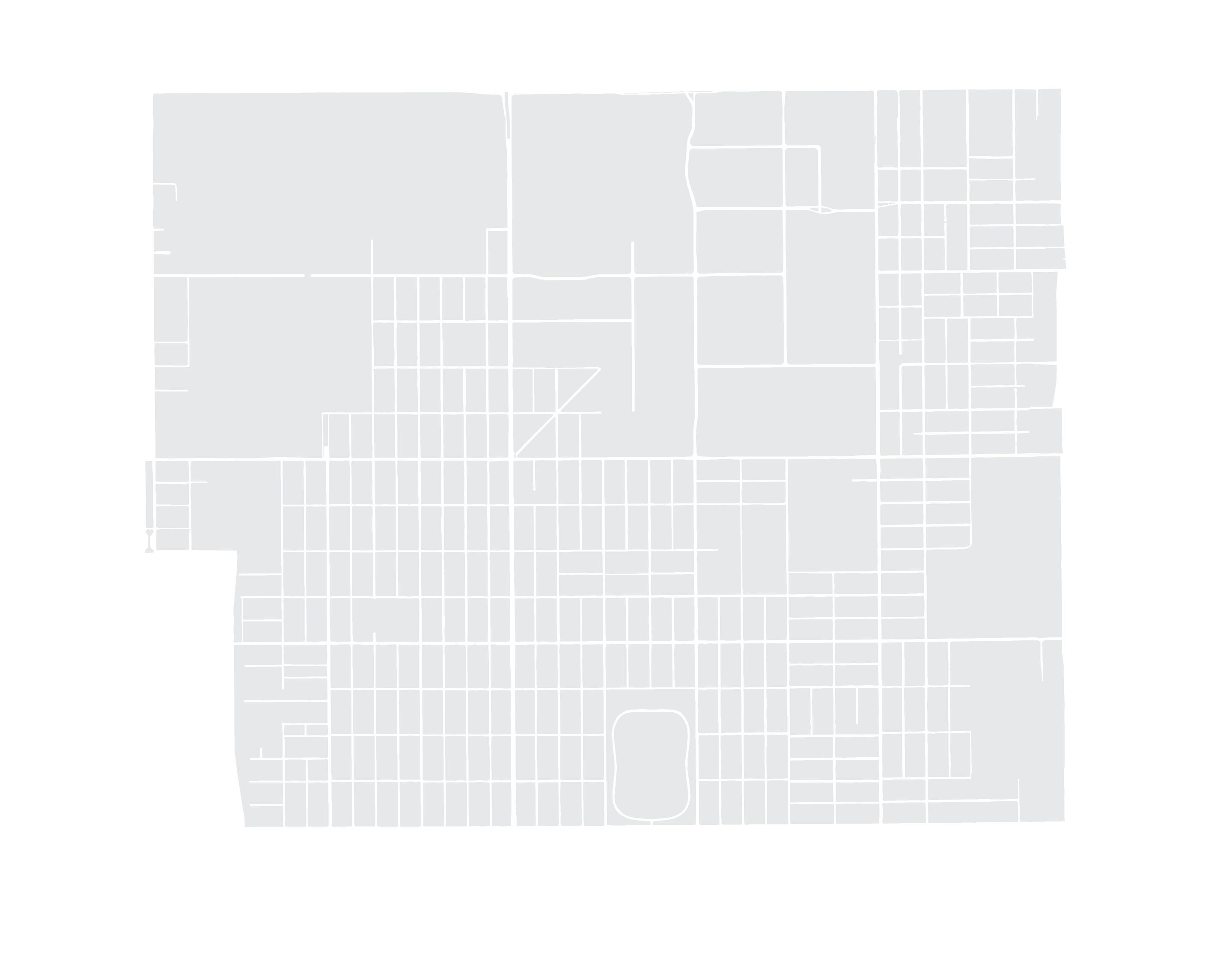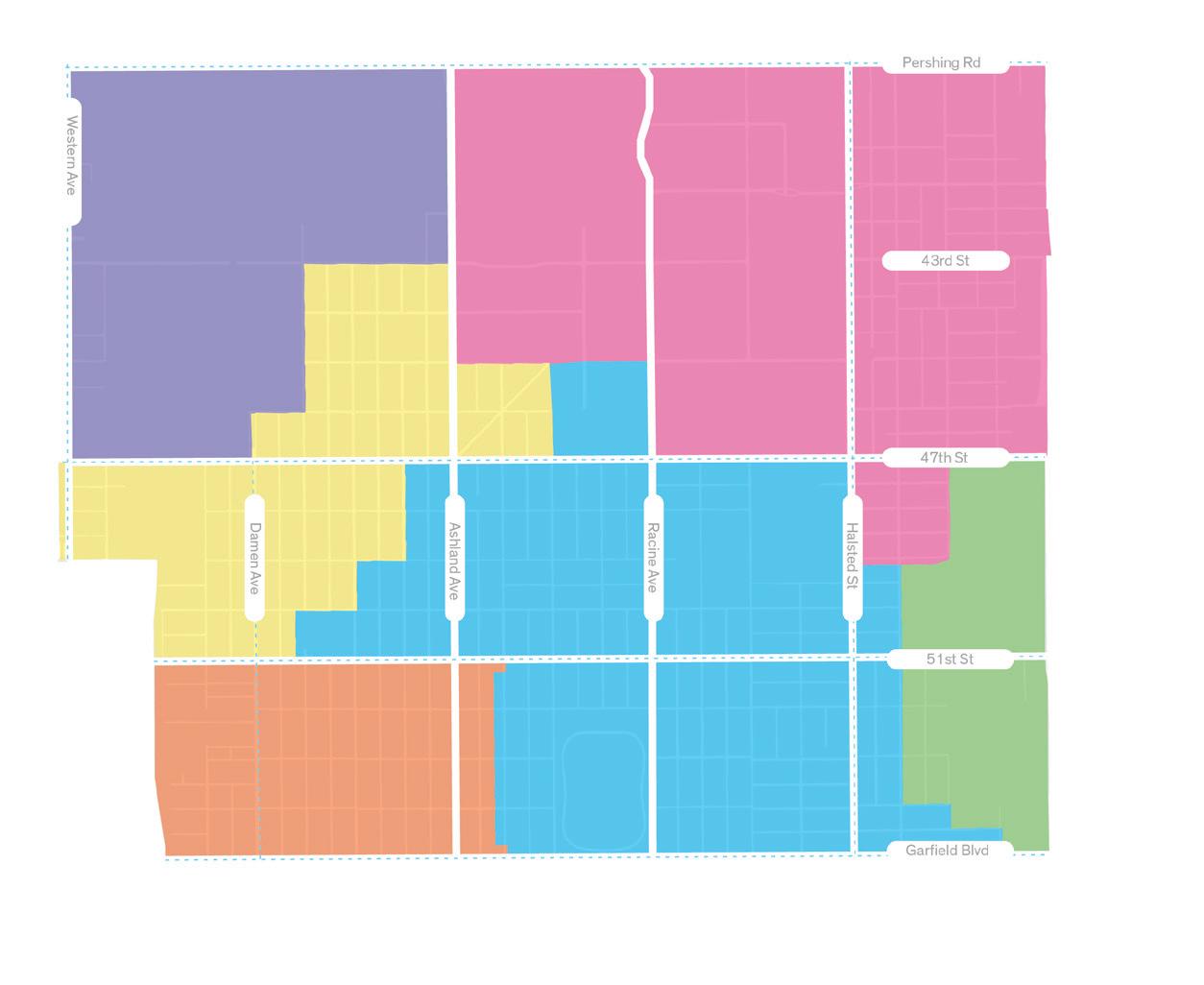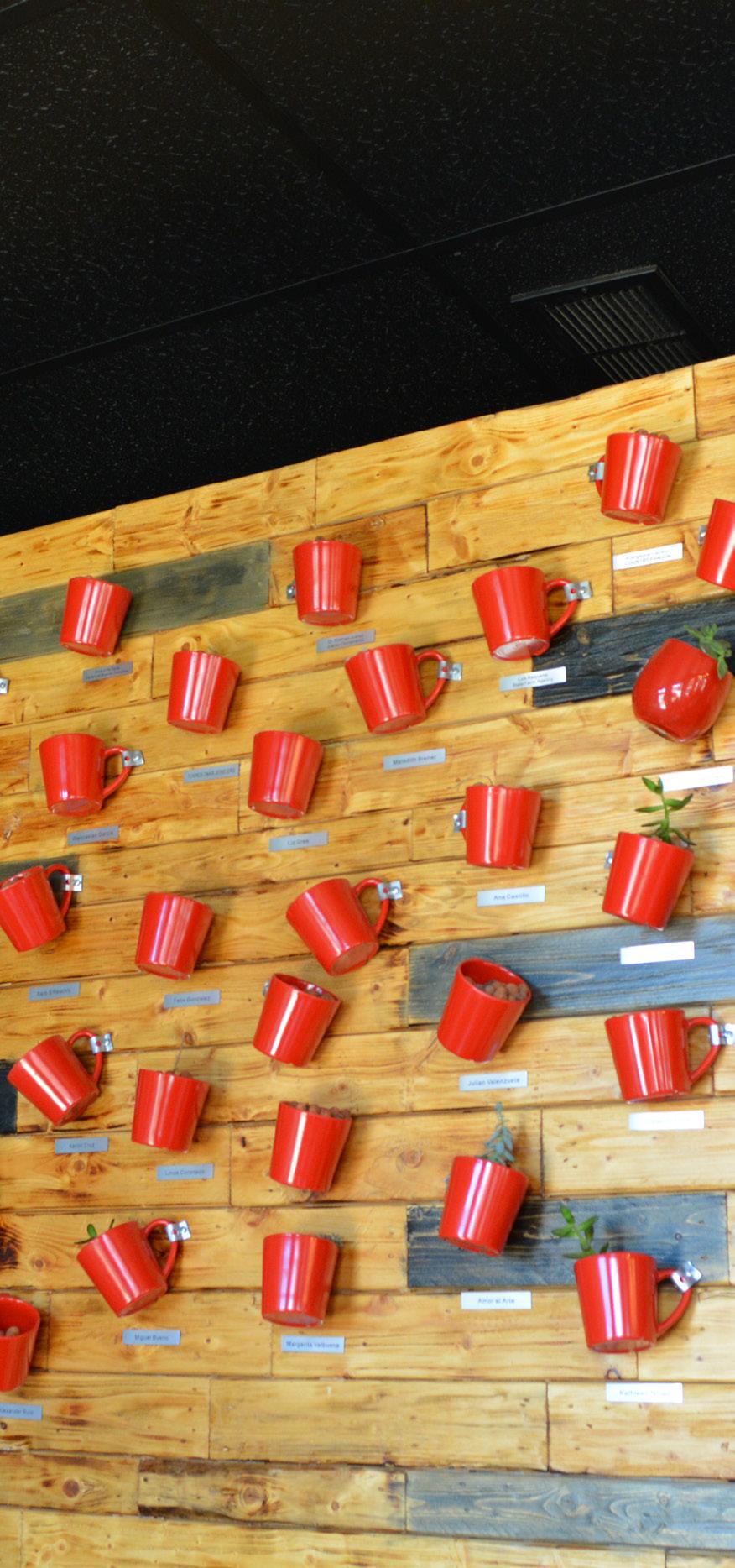
10 minute read
Civic Engagement and Community Relations
Civic Engagement & Community Relations
We will strive to unify our neighbors through enhanced outreach efforts and collective initiatives to bolster neighborhood conditions and give residents a voice.
Advertisement
Many of the goals and objectives under the Back of the Yards Community Plan require the participation of residents and stakeholders to advocate and carryout its neighborhood-stabilizing initiatives.
Given that Back of the Yards is comprised of four separate wards, it has been challenging to distribute public resources and services in an effective and comprehensive manner. The separation of the wards has made it difficult for public programs and funding to reach their fullest potential and serve the entire Back of the Yards community. Citizen representation in local government is also undermined because the collective voice of the community is fragmented and weakened by the separation of wards.
While increasing the amount of public and private resources to Back of the Yards should be prioritized, existing resources and services should be coordinated more efficiently to reach the most people possible. This can be done by promoting neighborhood forums and events, as well as electronic methods of spreading information, such as a Facebook group. This will allow residents to take advantage of programs and services that are already offered in the community.
Issues related to public safety also undermine the community’s capacity for self-governance. Leadership is needed in various forms to reduce barriers to engagement and improve relations within the neighborhood. A representational neighborhood-wide council could help bridge gaps while other communication tools could be used to improve civic knowledge.
A strong network of churches is also a key asset that the neighborhood can utilize to gather people, spread information, and work toward a more engaged community. Local faith leaders explain:
Long before Saul Alinsky helped to pull together the various strands of ethnic groups, the Churches created multiple levels of community cohesion. They created a “parallel universe” for the packers who were under such pressure from the companies. The diverse geography today and its access would render such a close-knit system to be difficult to maintain.
The churches still have three special routes of contribution. The first is communication. We see several thousand people every week and can be a source of both communicating events and become a listening forum for the many groups active in the community. The second is public space. Like the library, the high school, park district, there are meeting spaces that can be used to stimulate the quality of life. The presence and activity of the churches can give credibility to activities and especially to grant proposals, and other requests for resources for the community.
The strategies that follow seek to cultivate a culture of civic engagement and selfgovernance in Back of the Yards. In doing so, a stronger, more unified community will be in a better position to address the challenges of today and tomorrow.
Civic Resources
4
3
Pershing Rd
43rd St
5
2
Damen Ave Ashland Ave Racine Ave
1
Halsted St 47th St
51st St
6
Figure 12: Civic Offices and Assets City of Chicago Government Office Chicago Fire Department Chicago Fire Department Chicago Fire Department Chicago Public Library, Back of the Yards Chicago Public Library, Sherman Park 1 2 3 4 5 6

Back of the Yards Neighborhood Plan Garfield Blvd
Figure 13: Wards 12th Ward 15th Ward 20th Ward 16th Ward 3rd Ward 11th Ward


Figures 12, 13: New City Civic Resources. Source: Great Cities Institute Asset Mapping, City of Chicago Data Portal. Maps Created by Great Cities Institute.
Resident Vision Ideas
• Create a one neighborhood, one ward campaign • Implement peace and nonviolence programs • Devise a more equitable way to divide the money from city Alderman’s office • Pay less in taxes • Reach 100% voter participation by brainstorming ways for all residents to participate • Bridge the gap between Black and Latino community members by respecting each other’s culture • Organize cultural events that are designed to entertain the community as a whole • Municipal Permit Access reform
Five separate wards comprise BOTY 3rd Ward: Pat Dowell 11th Ward: Patrick Daley Thompson 12th Ward: George Cardenas 15th Ward: Raymond A. Lopez 16th Ward: Toni L. Foulkes 20th Ward: Willie B. Cochran
Three Cook County Commissioners District 2: Dennis Deer District 7: Alma E. Anaya District 11: John Daley Three State Representatives House District 1: Aaron Ortiz House District 2: Theresa Mah House District 6: Sonya M. Harper
Two State Senators Senate District 1: Antonio Muñoz Senate District 3: Mattie Hunter
Objectives
Objective 1
By providing residents with opportunities to gather and develop leadership skills, they will be able to coordinate efforts to increase funding and services to the neighborhood. Developing stronger Neighborhood Advisory Councils for each ward can provide better representation for residents and also allow community members to engage with one-another and help design and implement strategies that will benefit the entire community.
Objective 2
The Back of the Yards neighborhood is currently comprised of sections from four different wards, the 12th, 15th, 16th, and 20th. A unified community under one ward or legislative district would better represent the neighborhood to the City Council. Public resources and services could be allocated more effectively to a unified community. Additionally, economic development policies specific to the entire Back of the Yards community could be implemented more readily.

Back of the Yards Coffee Co., a community meeting spot. Source: Great Cities Institute, 2018.
Objectives
Objective 3 Case Study
If moderated effectively, a Back of the Yards community Facebook group could provide residents and stakeholders with a familiar and accessible platform to exchange information, organize events, and engage in public debate. Such events could include cultural events, volunteer opportunities, resource fairs, and community gardening projects.
Pilsen Neighborhood Facebook Group, Chicago, IL
The Pilsen Neighborhood Facebook page promotes local talents, businesses, organizations, and events in the Pilsen community. The Facebook page supports the involvement of local residents to improve, lead, and inspire pro-active efforts at a grass-roots level while creating an open atmosphere encouraging people’s opinions, dialogues and ideas and condemning any gang-related content or behavior (including bullying). The group is managed by independent community members with no connections to any political groups or organizations.
Objective 4
Ensuring that Back of the Yards remains a safe and accepting community for immigrant and refugee families is essential to the neighborhood’s stability. English as a Second Language courses, job training courses, and social events can help residents learn skills, support one another, educate themselves about current issues, and give them a voice in Back of the Yards affairs. Providing immigrants and refugees with formal spaces to convene with community members can also help them to quickly integrate into life in a new community.
Objectives
Objective 5
As a community in a sanctuary city for all residents, regardless of immigration status, the Back of the Yards community should establish partnerships with legal firms and clinics. This could improve access to legal services or the neighborhood’s most vulnerable residents, particularly the undocumented.
Case Study
Chicago Legal Clinic, Chicago, IL
Since 1981, the Chicago Legal Clinic has evolved from a small neighborhood office to a keystone provider of legal services to the working poor and disadvantaged in the Chicago area. This entails providing direct legal counseling and high quality representation at low cost or pro bono and free educational seminars on legal topics. Through our efforts, hundreds of clients have received legal protection from domestic violence, had their immigration status formalized, adopted children and been rescued from foreclosure. Thousands more received representation in other areas, including landlord/tenant, guardianships, consumer issues and the quest for social security disability benefits.
Objective 6
Exploring ways in which community organizations can collaborate and work with one another to achieve similar goals can expedite beneficial exchanges in the neighborhood. Organizations such as the Back of the Yards Neighborhood Council, Casa Norte, The Resurrection Project, Neighborhood Housing Services, Spanish Coalition for Housing, Plant Chicago, and other various groups focusing on health, education, art, and economic development may have overlapping interests allowing for opportunities to work together.
(Source: Chicago Legal Clinic.)
Objective 1
Strategies
Develop programs and engagement strategies that promote selfgovernance of the community. a. Assess current organizing efforts and bridge gaps between people of color and all residents of Back of the Yards, creating opportunities for people to gather, participate together, and voice their concerns. Lead Organization(s)
b. Promote and increase access to adult education programs that support leadership and civic engagement.
c. Increase voter participation by analyzing current voter levels and hosting citizenship workshops, voter registration drives, and forums to meet representatives.
d. Create a representative neighborhood-wide council that includes undocumented residents, youth, and marginalized populations that develops legislative priorities, addresses specific neighborhood concerns, and promotes civic engagement.
e. Analyze, communicate, coordinate, and increase private and public funding that comes into the neighborhood. Make this information accessible to community groups in order to coordinate the request for and use of funds. Peace & Education Coalition Partnering Organization(s)
CPS, BYNC, TRP
Objective 2
Strategies
Begin a One Neighborhood, One Legislative District campaign for Back of the Yards. Lead Organization(s) a. In anticipation of the 2020 census, promote participation from the local residents, educate about the importance of the census, and advocate for a safe and confidential process that residents are not afraid to participate in. Peace & Education Coalition b. Utilize updated and accurate census data to help promote the unification of Back of the Yards into one ward/legislative dristrict. c. Meet with and ask all current elected officials in all levels of electoral districts for support of our “One Neighborhood, One Ward” unification campaign. Partnering Organization(s)
BYNC, TRP
Objective 3
Strategies
Promote information for neighborhood residents about forums, gatherings, and means of communication that promote well-being. a. Encourage participation in the Peace and Education Coalition meetings and related gatherings that foster neighborhood networks promoting education, family support, and peace building through social justice. b. Promote knowledge of the Facebook page “We Are Back of the Yards” where residents can connect and share information with one another. c. Promote resident participation in both formal and informal spaces where residents can gather, share resources, organize, and advocate, such as volunteer clubs, resource fairs, and community gardening events. Lead Organization(s)
Peace & Education Coalition
Strategies a. Identify organizations that provide ESL courses and job training to immigrants and refugees.
b. Organize events where residents can learn about community resources, as well as receive support for themselves and their families. Lead Organization(s)
Peace & Education Coalition
Objective 5 Partner with legal entities to support vulnerable residents. Lead Organization(s) Strategies a. Identify legal firms and clinics that are known to support vulnerable populations, such as undocumented immigrants and refugees.
Peace & Education Coalition b. Communicate with organizations and collaborate with them to identify and plan the best methods of reaching out to and supporting vulnerable community members. c. Organize outreach to residents to ensure that they are aware of organizations that are available to help and support them. Partnering Organization(s)
BYNC, TRP
Partnering Organization(s)
CPS, BYNC, TRP
Partnering Organization(s)
BYNC, TRP
Objective 6
Strategies
Increase communication between community organizations so they can work together to achieve similar goals. Lead Organization(s) a. Devise and agree upon a method or platform for sharing information between organizations. Consider creating a volunteer or paid position that is responsible for communicating with organizations, compiling information, and devising methods of collaboration.
BYNC b. Actively consider other organizations that may have similar goals when planning events and applying for funding. c. Share contacts and resources with other community organizations.


Partnering Organization(s)
Peace & Education Coalition, TRP
Back of the Yards community visioning, 2017(Left). Community Event, 2019 (Right). Source: Great Cities Institute, 2019.
Mural on 47th Street. Source: Great Cities Institute, 2018.









